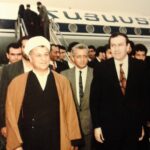While we know a great deal about the benefits of regional integration, there is a knowledge gap when it comes to areas with weak, dysfunctional or nonexistent regional fabric in political and economic life. Furthermore, deliberate “un-regioning,” applied by actors external as well as internal to a region, has also gone unnoticed despite its increasingly sophisticated modern application by Russia in its peripheries.
This volume helps us understand what Anna Ohanyan calls “fractured regions” and their consequences for contemporary global security. Ohanyan introduces a theory of regional fracture to explain how and why regions come apart, consolidate dysfunctional ties within the region, and foster weak states.
Russia Abroad specifically examines how Russia employs regional fracture as a strategy to keep states on its periphery in Eurasia and the Middle East weak and in Russia’s orbit. It argues that the level of regional maturity in Russia’s vast vicinities is an important determinant of Russian foreign policy in the emergent multi-polar world order.
Many of these fractured regions become global security threats because weak states are more likely to be hubs of transnational crime, havens for militants, or sites of protracted conflict.
The regional fracture theory is offered as a fresh perspective about the post-American world and a way to broaden international relations scholarship on comparative regionalism.
Laurence Broers
—
Anna Ohanyan is Richard B. Finnegan Distinguished Professor of Political Science and International Relations at Stonehill College. She is the author of Networked Regionalism as Conflict Management and NGOs, IGOs and the Network Mechanisms of Post-Conflict Global Governance in Microfinance.
Reviews
“This is not just a book about Russian foreign policy. The new conceptualization of regional fracture and the accompanying theoretical framework are broadly applicable and provide an important counterweight to the often exclusive focus on regional integration in the scholarly and policymaking communities.”—Paul F. Diehl, Associate Provost and Director, Center for Teaching and Learning, Ashbel Smith Professor of Political Science, University of Texas-Dallas
—
“Regions in International Relations are already subject to intensive if contested analysis. Lacking in that ever-expanding literature, however, is attention to regional fracture. This volume’s impressive quality of contributors and cases provides empirically-rich understandings of Russian foreign policy and security issues concerning the former Soviet Union and further afield. It goes further still, offering valuable insights to the wider IR community about regional fracture as process.”—Rick Fawn, Professor of International Relations, University of St Andrews, UK
Table of Contents
Acknowledgments
Introduction: Margins Matter
Anna Ohanyan
Part I: Theory of Regional Fracture
- Theory of Regional Fracture in International Relations: Beyond Russia
Anna Ohanyan
2. From Donbass to Damascus: Russia on the Move
Robert Nalbandov - Part II: Lenin’s Revenge: Regional Fracture in the Post-Soviet Space
3. Fractured Eurasian Borderlands: The Case of Ukraine
Vsevolod Samokhvalov
4. The South Caucasus: Fracture without End?
Laurence Broers
5. Small States and the Large Costs of Regional Fracture: The Case of Armenia
Richard Giragosian
6. Central Asia: Fractured Region, Illiberal Regionalism
David G. Lewis - Part III: Postcolonial Roots of Regional Fracture beyond the Post-Soviet Space
7. Stuck in Between: The Western Balkans as a Fractured Region
Dimitar Bechev
8. Syria and the Middle East: Fracture Meets Fracture
Mark N. Katz - Conclusion: Overcoming Regional Fracture
Anna Ohanyan
References
List of Contributors
Index
—-
The book develops the Theory of Regional Fracture, which is then applied empirically to conflict areas around Russia’s geopolitical beltway, from Donbass to Damascus. It has been exciting to work with top-notch area specialists on Russia, Ukraine, the Western Balkans, the South Caucasus, the Central Asia, and the Middle East.
The authors of the empirical chapters include Robert Nalbandov on Russia, Vsevolod Samokhvalov on Ukraine, Dimitar Bechev on the Western Balkans, Laurence Broers on South Caucasus, Richard Giragosian on Armenia, David Lewis on Central Asia, and Mark Katz on the Middle East.
I have been fortunate to developed this project as an edited volume, working with this talented team as opposed to tackling the subject as a monograph, on my own. A big thanks to each one of them, and I hope you will explore the scholarship of these influential authors. I am also deeply indebted to the hundreds of respondents in Armenia, Georgia, Bosnia and Herzegovina, Russia, Brussels and US/Washington, DC. I am thankful to the Fulbright Commission, Stonehill College, and the University of Southern California/Institute of Armenian Studies for much needed financial support to carry out the fieldwork for the project. My students/LION Scholars Erica Cordatos and Daniel Lavigne of Stonehill College played a key role in conducting the fieldwork in Armenia.
Also to note that we will hold a roundtable panel on this book at the International Studies Association (ISA) in San Francisco on April 7, next week. Only some of the chapter authors will be present with me, however. We do plan on launching the book more formally in the Boston later this year.
Anna Ohanyan











